Categories
Left column house ads
Seen & Heard: ICE in Tribeca
July 6, 2018 Arts & Culture, Community News, Real Estate, Restaurant/Bar News, Shopping
••• This is horrifying.
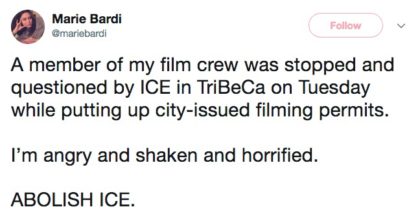 ••• I found a stash of Tribeca Citizen totes. You can pick one up for free at the Giorgia lingerie store on Greenwich while supplies last.
••• I found a stash of Tribeca Citizen totes. You can pick one up for free at the Giorgia lingerie store on Greenwich while supplies last.
 ••• The reader known as Hudson River spotted “we’re hiring” flyers at the Brookfield Place outpost of Seamore’s—which will also evidently have an Airstream trailer parked outside.
••• The reader known as Hudson River spotted “we’re hiring” flyers at the Brookfield Place outpost of Seamore’s—which will also evidently have an Airstream trailer parked outside.
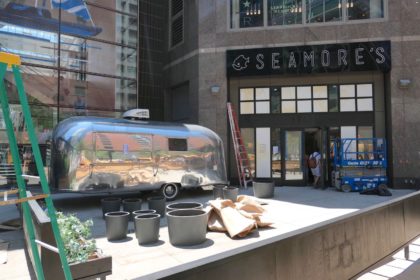 ••• The former Emigrant Savings Bank at 261 Broadway (Chambers/Warren) has gone under the plywood. The Department of Buildings permit says the limestone facade will be restored, which is good news, because the pinkish one there now is severely dated. As for what’s moving in, I heard it’ll be a shoe store. Could that mean Shoegasm, which used to be further up Broadway?
••• The former Emigrant Savings Bank at 261 Broadway (Chambers/Warren) has gone under the plywood. The Department of Buildings permit says the limestone facade will be restored, which is good news, because the pinkish one there now is severely dated. As for what’s moving in, I heard it’ll be a shoe store. Could that mean Shoegasm, which used to be further up Broadway?
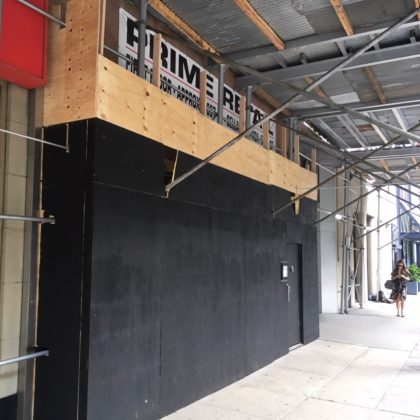 ••• The owner of 131 Duane has filed for a rooftop addition; the Landmarks Preservation Commission says it’s under review. If the addition was every mocked up, I never saw it (which would only be good news). Now if they’d get rid of the dead plants outside the old City Hall restaurant….
••• The owner of 131 Duane has filed for a rooftop addition; the Landmarks Preservation Commission says it’s under review. If the addition was every mocked up, I never saw it (which would only be good news). Now if they’d get rid of the dead plants outside the old City Hall restaurant….
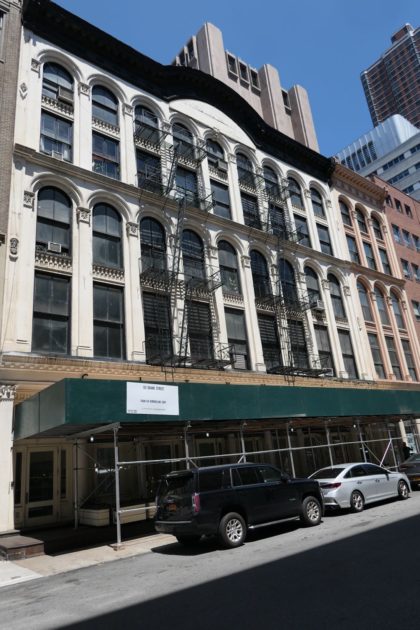 ••• “Modern Persuasion” shoots Sunday in the White/W. Broadway area. Seems likely to be an adaptation of Sara Marks’s contemporary take on Jane Austen’s Persuasion.
••• “Modern Persuasion” shoots Sunday in the White/W. Broadway area. Seems likely to be an adaptation of Sara Marks’s contemporary take on Jane Austen’s Persuasion.
12 Comments
Comment:
Subscribe
Subscribe to the TC Newsletter







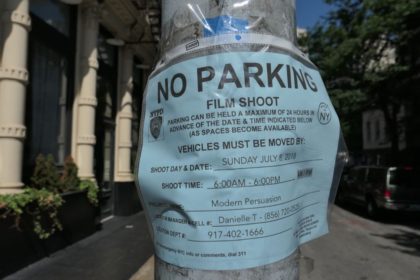






Another option for 261 Broadway could be DSW. Their Battery Park City Store is closed.
How many more shoots in this area before the embargo kicks in? The first 6 months of 2018 have seen numerous permits issued here.
The shoots don’t bother me as long as the crews are polite and considerate. Sometimes I even enjoy watching the shoot in action.
(They seem to shoot almost every week on our block).
ICE rounding up immigrants is eerily reminiscent of the Gestapo rounding up Jews for “relocation.” The more vulnerable a group is, the more likely they are to be targeted for attack by our new dictator. It is horrifying.
It seems to me that one goes too far by comparing the relocation and extermination of a country’s own citizens to the detention of illegal immigrants. Certain actions can be fairly described as terrible without people having to race to the Hitler / Nazi analogies.
Confirming legal immigration status and shipping folks to concentration camps are hardly comparable.
This is a refreshing take, Scott.
Tell me Scott, how may times are you stopped and asked to confirm your immigration status? Get out of here with your bullshit.
No one is saying that ICE’s behavior is appropriate, just watch those analogies…!
I love the film shoots in the neighborhood. It’s all part of being in NYC. From the looks of it, they sure seem to create a lot of jobs in the area too.
Like what? Can you give examples of the jobs they create? For people who live in the area?
https://www.villagevoice.com/2017/10/11/new-york-is-throwing-money-at-film-shoots-but-who-benefits/
“There have now been multiple state-level studies of film subsidies, [Michael Thom, a USC public policy professor who has studied film tax breaks nationwide] says, and ‘all of them come to this conclusion it’s a negative return on investment.’
“And even if a positive impact does exist, New York’s film industry spending may just be a way of treading water: a zero-sum game where states compete to throw increasing amounts of tax money at the same number of jobs. It’s a problem that corporate-subsidy experts in other industries have dubbed ‘the economic war among the states’ — and it serves mostly to funnel money out of public treasuries and into private pockets.
[…]
“The number of people employed in New York in ‘motion picture and sound recording’ (the state’s designation) and ‘motion picture and video production’ (the feds’) actually appears to have gone down in recent years, despite the subsidies, notes Thom. The former, at an average of about 58,000 individuals, is about the same as it was in 2000 — though there was a slight dip in 2003 and 2004, after Canada’s subsidies took full effect and before New York’s kicked in — and both have declined slightly since 2013.
“How could one set of numbers show that film tax credits have led to a huge boom in production jobs, while others show little to no effect? One issue is that the state’s audits separately report each job stint, no matter how short, rather than converting to ‘full-time equivalent’ jobs — a tiny footnote in the Camoin study [for New York State government’s “Empire State Development” authority of the film and TV industry] indicates that ‘if one person is employed part-time for four months, then takes two months off and is hired again for four months that would be counted as two jobs.’ As a result, the official state numbers double- or triple-count crew members who work on multiple productions in one year.
“Another likely factor is that while the city has undoubtedly seen a jump in the total number of TV shoots, the number of hours worked may not be keeping pace. That’s because more and more local productions are for streaming services like Netflix and Amazon, which have both shorter seasons and smaller crews. ‘Netflix and the like come at it more from an indie-film attitude,’ with lower budgets, says [Joseph] Stephans [, an indie film producer (Wildlike) and location manager]. ‘Network jobs economically are much more attractive than streaming jobs.’
“Meanwhile, there’s still the question of how much of this frenetic filming pace is attributable entirely to state cash handouts. The 2017 Camoin Associates audit determined that New York State paid out $1.36 billion in subsidies across 2015 and 2016, while bringing in $1.55 billion in state and city tax money — a 14.5 percent return on taxpayers’ investment. But that assumes that none of that tax revenue would have come in without the credits — that, in other words, all currently subsidized film and TV production in New York would dry up if the state weren’t paying for it.
“Some productions would undoubtedly take place here regardless — The Daily Show didn’t decamp for Vancouver even when a subsidy gap existed, and The Defenders aren’t likely to start patrolling Yonge Street. Thom says that a study by the California legislature estimated that one-third of production activity in that state would take place in that state with or without subsidies. If the same ratio holds true in New York, then even if the state cut off the subsidy spigot and two-thirds of productions hightailed it to more budget-friendly climes, the state would still collect more than $250 million a year in tax revenues on an expense of zero dollars. With the current program running about a $100 million annual return by the state’s own figures, this implies that New York state would bring in about $150 million a year more in net revenues if it cut off film credits entirely — money it could conceivably then spend on more effective job-creation programs.
“Subsidies for film and TV production in New York aren’t going away anytime soon: Cuomo’s latest budget extended the program three more years, until 2022, and both the Motion Picture Association of America and film production unions have lobbied hard to keep it in place. (A bill to add a ‘diversity credit’ for salaries of TV writers and directors who are women or people of color has already passed the state legislature and is awaiting Cuomo’s signature.)
“If you’re employed in the TV or movie industries in New York, that’s good: With the state paying 30 percent of your paychecks, that means producers are likely to be much more free with their spending. If you’re a New York State resident whose only tie to local entertainment production is watching Jessica Jones tear up Hell’s Kitchen, though, you’re paying a high price with your tax dollars. Maybe you’re right to gripe about that catering truck after all.”